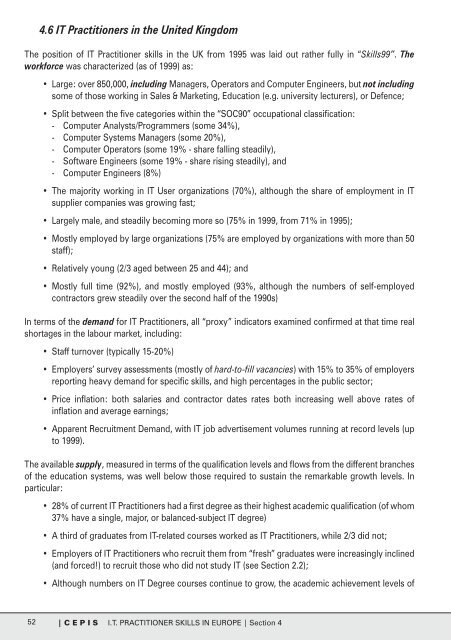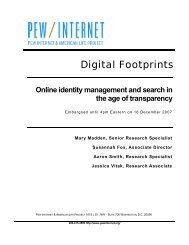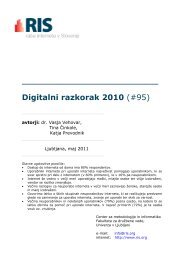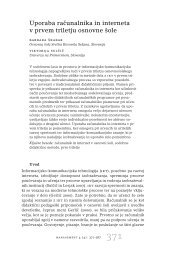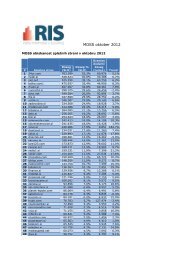the Labour Market Survey Report - Council of European ...
the Labour Market Survey Report - Council of European ...
the Labour Market Survey Report - Council of European ...
You also want an ePaper? Increase the reach of your titles
YUMPU automatically turns print PDFs into web optimized ePapers that Google loves.
4.6 IT Practitioners in <strong>the</strong> United Kingdom<br />
The position <strong>of</strong> IT Practitioner skills in <strong>the</strong> UK from 1995 was laid out ra<strong>the</strong>r fully in “Skills99”. The<br />
workforce was characterized (as <strong>of</strong> 1999) as:<br />
• Large: over 850,000, including Managers, Operators and Computer Engineers, but not including<br />
some <strong>of</strong> those working in Sales & <strong>Market</strong>ing, Education (e.g. university lecturers), or Defence;<br />
• Split between <strong>the</strong> five categories within <strong>the</strong> “SOC90” occupational classification:<br />
- Computer Analysts/Programmers (some 34%),<br />
- Computer Systems Managers (some 20%),<br />
- Computer Operators (some 19% - share falling steadily),<br />
- S<strong>of</strong>tware Engineers (some 19% - share rising steadily), and<br />
- Computer Engineers (8%)<br />
• The majority working in IT User organizations (70%), although <strong>the</strong> share <strong>of</strong> employment in IT<br />
supplier companies was growing fast;<br />
• Largely male, and steadily becoming more so (75% in 1999, from 71% in 1995);<br />
• Mostly employed by large organizations (75% are employed by organizations with more than 50<br />
staff);<br />
• Relatively young (2/3 aged between 25 and 44); and<br />
• Mostly full time (92%), and mostly employed (93%, although <strong>the</strong> numbers <strong>of</strong> self-employed<br />
contractors grew steadily over <strong>the</strong> second half <strong>of</strong> <strong>the</strong> 1990s)<br />
In terms <strong>of</strong> <strong>the</strong> demand for IT Practitioners, all “proxy” indicators examined confirmed at that time real<br />
shortages in <strong>the</strong> labour market, including:<br />
• Staff turnover (typically 15-20%)<br />
• Employers’ survey assessments (mostly <strong>of</strong> hard-to-fill vacancies) with 15% to 35% <strong>of</strong> employers<br />
reporting heavy demand for specific skills, and high percentages in <strong>the</strong> public sector;<br />
• Price inflation: both salaries and contractor dates rates both increasing well above rates <strong>of</strong><br />
inflation and average earnings;<br />
• Apparent Recruitment Demand, with IT job advertisement volumes running at record levels (up<br />
to 1999).<br />
The available supply, measured in terms <strong>of</strong> <strong>the</strong> qualification levels and flows from <strong>the</strong> different branches<br />
<strong>of</strong> <strong>the</strong> education systems, was well below those required to sustain <strong>the</strong> remarkable growth levels. In<br />
particular:<br />
• 28% <strong>of</strong> current IT Practitioners had a first degree as <strong>the</strong>ir highest academic qualification (<strong>of</strong> whom<br />
37% have a single, major, or balanced-subject IT degree)<br />
• A third <strong>of</strong> graduates from IT-related courses worked as IT Practitioners, while 2/3 did not;<br />
• Employers <strong>of</strong> IT Practitioners who recruit <strong>the</strong>m from “fresh” graduates were increasingly inclined<br />
(and forced!) to recruit those who did not study IT (see Section 2.2);<br />
• Although numbers on IT Degree courses continue to grow, <strong>the</strong> academic achievement levels <strong>of</strong><br />
52<br />
| C E P I S I.T. PRACTITIONER SKILLS IN EUROPE | Section 4


